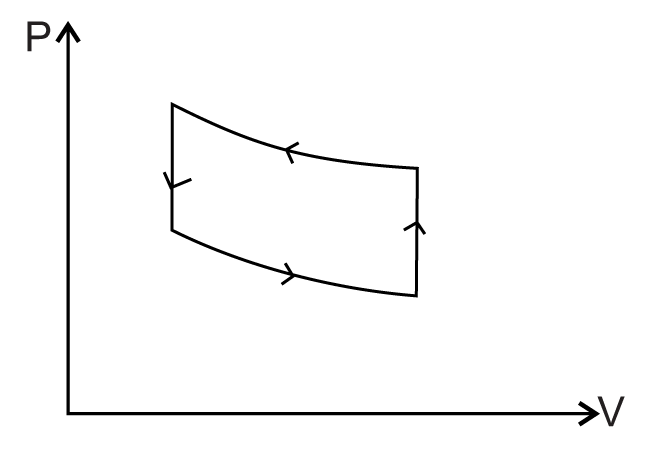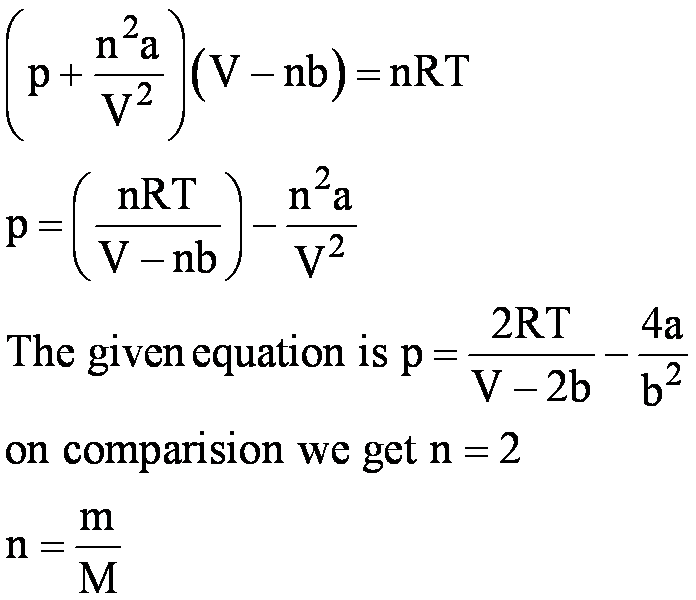AIIMS Practice Paper Physics
1. Four metallic plates, each with a surface area of one side A are placed at a distance d apart from each other. The two inner plates are connected to point B and the other two plates to another point A as shown in figure. Then the capacitance of the system is

(a) ε0 A/d
(b) 2ε0 A/d
(c) 3ε0 A/d
(d) 4ε0 A/d
2. Three masses 2, 3 and 4 kg are located at the corners of an equilateral triangle of side 2m. The centre of mass of the system is
(a) (0.77, 1.11)
(b) (1.11, 0.77)
(c) (1.77, 0.11)
(d) (0.11, 1.77)
35. Angle of dip at a place is 60°. If BH is the horizontal component of earth’s magnetic field, the total field intensity is
(a) ![]()
(b) 2 BH
(c) ![]()
(d) ![]()
36. An object executing S.H.M. attached to a spring has displacement meter. Find the time at which the maximum speed 1st occurs.
meter. Find the time at which the maximum speed 1st occurs.
(a) 0.5 s
(b) 1.5 s
(c) 2s
(d) 2.5 s
37. 7 mole of an ideal tri atomic gas (γ = 1.33) are heated at constant pressure. If 266 J of heat energy is supplied to the gas find the work-done by the gas.
(a) 66 J
(b) 34 J
(c) 432 J
(d) 102 J
38. By the introduction of glass plate (μ = 1.5), the fringes of young’s double slit experiment get displaced by distance x. When this plate is replaced by another plate of same thickness, the shifting of fringes becomes ![]() . The refractive index of the 2nd plate is
. The refractive index of the 2nd plate is
(a) 1.58
(b) 1.45
(c) 1.75
(d) 1.25
39. The ratio of intensities between two coherent sound sources is 9 : 4. The difference of loudness in decibel between maximum and minimum intensity when they interfere in space is
(a) 15 log 5
(b) 20 log 5
(c) 10 log 5
(d) 5 log 5
40. An engine of power 160 KW draws a train of mass 18 × 104 kg up in an inclination of 1 in 40. The frictional resistance is 5 kg wt/1000 kg. Find the maximum speed.
(a) 2.962 m/s
(b) 1.48 m/s
(c) 3.14 m/s
(d) 4.2 m/s
41. A parallel plate condenser with a dielectric of dielectric constant K between the plates has a capacity C and is charged to a potential V volt. The dielectric slab is slowly removed from the plates and then reinserted. The net work done by the system in this process is:
(a) Zero
(b) 
(c) 
(d) ![]()
42. A 25 W and 100W bulb are joined in series and connected to the mains. Which bulb will glow brighter?
(a) 25 W bulb
(b) 100 W bulb
(c) Both bulbs will glow brighter
(d) None will glow brighter
43. What is the de-Broglie wavelength of an electron in the 2nd orbit of a hydrogen atom?
(a) ![]()
(b) πr
(c) 2πr
(d) πr2
44. A coil has a self inductance of 10 mH. What is the maximum magnitude of induced emf in the inductor when a current I = 0.1 sin 200 t ampere is sent through it?
(a) 0.2 V
(b) 0.3 V
(c) 0.5 V
(d) 0.4 V
45. A 100 PF capacitor is connected to a 230 V, 50 Hz a.c. source. What is the r.m.s. value of the conduction current?
(a) 4.8 μA
(b) 7.2 μA
(c) 8.4 μA
(d) 6.7 μA
46. The electrostatic potential inside a charged spherical ball is given by Φ = ar2 + b where r is distance from the centre a, b are constants. Then the charge density inside the ball is
(a) −6aε0r
(b) −24πaε0
(c) −6ε0a
(d) −24πaε0r
47. Pressure of a gas decreases by 30% at a constant temperature. Find the percentage change in volume.
(a) ![]()
(b) ![]()
(c) ![]()
(d) ![]()
48. A force of 45 N is just able to move a block of wood weighing 9 kg on a rough horizontal surface. Find its co-efficient of friction. (use g = 10 m/s2)
(a) 1
(b) 0.5
(c) 0.4
(d) 0.3
49. A small sphere of volume V falls in a viscous fluid and attains a terminal velocity vt.What will be the terminal velocity of a sphere of volume 27 V, of same material falling in the same fluid?
(a) (3/2)vt
(b) 3vt
(c) 9vt
(d) 6vt
50. The extension of a wire by application of a load is 3 mm. The extension in a wire of same material and length but one third of the radius by applying same load is
(a) 36 mm
(b) 27 mm
(c) 9 mm
(d) 18 mm
51. Statement I: Propagation of light through an optical fibre is due to total internal reflection taking place at the core – clad interface.
Statement II: Refractive index of the material of the core of the optical fibre is greater than that of air.
(a) Statement I is true; Statement II is true; Statement II is not a correct explanation for Statement I.
(b) Statement I is true; Statement II is false
(c) Statement I is false; Statement II is true
(d) Statement I is true; Statement II is true ; Statement II is the correct explanation for statement I.
52. Statement I: Two heater coils made of same material are connected in parallel across the mains. The length and diameter of the first wire is double the second wire. The first wire will produce less heat.
Statement II: Length is immaterial for electric fuse of given current strength say I amp.
(a) Statement I is true; Statement II true; Statement II is not a correct explanation for Statement I.
(b) Statement I is true; Statement II is false.
(c) Statement I is false; Statement II is true.
(d) Statement I is true; Statement II is true ; Statement II is the correct explanation for statement I.
53. Assertion: When a bottle of cold carbonated drink is opened, a slight fog forms around the opening.
Reason: Adiabatic expansion of gas causes lowering of temperature and condensation of water vapour.
(a) If both assertion and reason are true and reason is a correct explanation of the assertion.
(b) If both assertion and reason are true and reason is not a correct explanation of the assertion.
(c) If assertion is true but reason is false.
(d) If assertion is false but reason is true.
54. Assertion: In a movie, ordinarily 24 frames are projected per second from one end to the other of the complete film.
Reason: The image formed on retina of eye is sustained upto 1/10 s after the removal of stimulus.
(a) If both the assertion and reason are true and reason is the correct explanation of the assertion.
(b) If both the assertion and reason are true but the reason is not correct explanation of the assertion.
(c) If the assertion is true but the reason is false.
(d) If the assertion is false but the reason is true.
55. Assertion : A tube light emits white light.
Reason : Emission of light in a tube takes place at a very high temperature.
(a) If both assertion and reason are true and the reason is the correct explanation of the assertion.
(b) If both assertion and reason are true but the reason is not the correct explanation of the assertion.
(c) If assertion is true but the reason is false.
(d) If both assertion and reason are false.
56. Assertion : A red object appears dark in the yellow light.
Reason : The red colour is scattered less.
(a) If both assertion and reason are true and the reason is the correct explanation of the assertion.
(b) If both assertion and reason are true but the reason is not the correct explanation of the assertion.
(c) If assertion is true but the reason is false.
(d) If both assertion and reason are false.
57. Assertion : By roughening the surface of a glass sheet its transparency can be reduced.
Reason : Glass sheet with rough surface absorbs more light.
(a) If both assertion and reason are true and the reason is the correct explanation of the assertion.
(b) If both assertion and reason are true but the reason is not the correct explanation of the assertion.
(c) If assertion is true but the reason is false.
(d) If both assertion and reason are false.
58. STATEMENT-1 : Total energy of revolving electron in any stationary orbit is negative.
STATEMENT-2 : Energy is a scalar quantity. It can have positive or negative values.
(a) Statement -1 is True , Statement – 2 is True ; Statement – 2 is a CORRECT explanation for Statement – 1
(b) Statement-1 is True, Statement-2 is True ; Statement-2 is a NOT CORRECT explanation for Statement-1
(c) Statement – 1 is True, Statement – 2 is False
(d) Statement-1 is False, Statement-2 is True
59. STATEMENT-1:TheBohr’smodel cannot differentiate between the spectra of hydrogen and deuterium.
STATEMENT-2 : The Bohr’s model considers the nucleus as infinitely massive in comparison to the orbiting electrons.
(a) Statement-1 isTrue, Statement-2 is True; Statement-2 is a CORRECT explanation for Statement-1
(b) Statement-1 isTrue,Statement-2 is True; Statement-2 is a NOT CORRECT explanation for Statement-1
(c) Statement – 1 is True, Statement – 2 is False
(d) Statement-1 is False, Statement-2 is True
60. STATEMENT.1 : A ball is projected at an angle θ with horizontal from a platform with constant velocity relative to platform. The platform is moving in horizontal direction as shown. The time of flight of ball is independent of the horizontal velocity of platform. (Neglect the air friction)

STATEMENT.2 : The time of flight of projectile depends only on vertical component of initial velocity and acceleration in vertical direction.
(a) Statement-1 is True, Statement-2 is True ; Statement-2 is a CORRECT explanation for Statement-1
(b) Statement-1 is True,Statement-2 is True ;Statement-2 is a NOT CORRECT explanation for Statement-1
(c) Statement – 1 is True, Statement – 2 is False
(d) Statement-1 is False, Statement-2 is True
Latest Govt Job & Exam Updates:


















































































 Hence statement-2 is correct explanation of statement-1.
Hence statement-2 is correct explanation of statement-1.